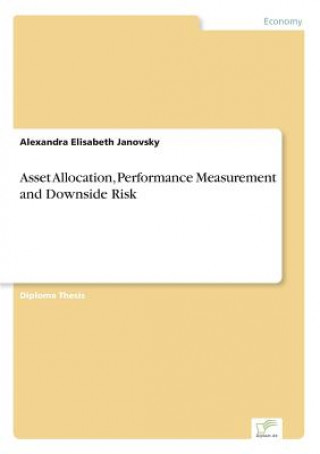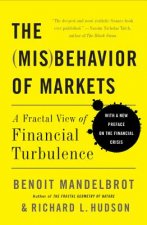
Kód: 02455756
Asset Allocation, Performance Measurement and Downside Risk
Autor Alexandra Elisabeth Janovsky
Diploma Thesis from the year 2001 in the subject Business economics - Investment and Finance, grade: 1,0, University of Vienna (unbekannt, Betriebswirtschaftslehre), language: English, abstract: Inhaltsangabe:Abstract:§Investors s ... celý popis
- Jazyk:
 Angličtina
Angličtina - Väzba: Brožovaná
- Počet strán: 124
Nakladateľ: Diplom.de, 2001
- Viac informácií o knihe

Mohlo by sa vám tiež páčiť
-

Advances in Microlocal Analysis
276.82 € -

Remote Sensing of Aquatic Coastal Ecosystem Processes
139.37 € -

Basics Landscape Architecture 02: Ecological Design
36.29 € -7 % -

Hedgefond Replikation
52.04 € -

Avatar, Der Herr der Elemente, Das Versprechen. Bd.2
10.01 € -4 % -

4C/ID Modell am Beispiel eines Bildungswissenschaftlers im Bereich Erwachsenenbildung
54.80 € -

Ergebnisse der Biologie
62.88 €
Darčekový poukaz: Radosť zaručená
- Darujte poukaz v ľubovoľnej hodnote, a my sa postaráme o zvyšok.
- Poukaz sa vzťahuje na všetky produkty v našej ponuke.
- Elektronický poukaz si vytlačíte z e-mailu a môžete ho ihneď darovať.
- Platnosť poukazu je 12 mesiacov od dátumu vystavenia.
Viac informácií o knihe Asset Allocation, Performance Measurement and Downside Risk
Nákupom získate 294 bodov
 Anotácia knihy
Anotácia knihy
Diploma Thesis from the year 2001 in the subject Business economics - Investment and Finance, grade: 1,0, University of Vienna (unbekannt, Betriebswirtschaftslehre), language: English, abstract: Inhaltsangabe:Abstract:§Investors should not and in fact do not hold a single asset, they hold groups or portfolios of assets. An important aspect in portfolio theory is that the risk of a portfolio is more complex than the risk of its components. It depends on how much the assets represented in the portfolio move together, that is, on the correlation between the single assets. In portfolio theory, there are several definitions of risk: First of all, the Capital Asset Pricing Model (CAPM) relies on the beta factor of an asset relative to the market as a measure for the asset s risk. On the other hand, also downside risk can be used in order to determine a portfolio s risk. The kind of risk in question is market risk, which is the risk of losses arising from adverse movements in market prices or rates. Market risk can be subdivided into interest rate risk, equity price risk, exchange rate risk and commodity price risk.§For many investment decisions, there is a minimum return that has to be reached in order to meet different criteria. Returns above this minimum acceptable return ensure that these goals are reached and thus are not considered risky. Standard deviation captures the risk associated with achieving the mean, while downside risk assumes that only those returns that fall below the minimal acceptable return incur risk. One has to distinguish between good and bad volatility. Good volatility is dispersion above the minimal acceptable return, the farther above the minimal acceptable return, the better it is.§One way of measuring downside risk is to consider the shortfall probability or chances of falling below the minimal acceptable return. Another possibility is measuring downside variance, i.e. variance of the returns falling below the minimal acceptable return.§As a consequence, downside variance is very sensitive to the estimate of the mean of the return function, while standard deviation does not suffer from this problem. Thus the calculation of downside deviation is more difficult than the calculation of standard deviation.§The quality of the calculation also depends on the choice of differencing interval of the time series. The calculation of downside risk assumes that financial time series follow either a normal or lognormal distribution.§Finally, there is no universal risk measure for the many broad categories of risk. For example, standard deviation captures the risk of not achieving the mean, beta captures the risk of investing in the assets available in the market, and downside deviation captures the risk of not achieving the minimal acceptable return necessary to accomplish some goal. They all provide useful information, but none of them provides all the information necessary to manage risk in every situation.§Inhaltsverzeichnis:Table of Contents:§1.Introduction3§2.Asset Allocation in a Downside Risk Framework4§2.1Expected Return4§2.2Variance and Standard Deviation4§2.3The Benefits of International Diversification5§2.4The Investment Process7§2.4.1Portfolio Selection7§2.4.2Asset Allocation Based on Alternative Risk Measures11§2.4.2.1Downside Risk Measures11§2.4.2.2Downside Risk Optimization12§3.Estimation of Correlation and Volatility15§3.1Correlation16§3.1.1Computation of Correlation16§3.1.2Properties of Correlation16§3.1.3Forecasting Correlation18§3.1.3.1Simple Moving Averages18§3.1.3.2Exponentially Weighted Moving Average (EWMA)18§3.1.3.3Factor Models19§3.1.4The Influence of Correlation on Portfolio Weights19§3.1.5Autocorrelation24§3.2Volatility25§3.2.1Calculation of Volatility25§3.2.2Properties of Vola...
 Parametre knihy
Parametre knihy
Zaradenie knihy Knihy po anglicky Economics, finance, business & management Economics
118.62 €
- Celý názov: Asset Allocation, Performance Measurement and Downside Risk
- Autor: Alexandra Elisabeth Janovsky
- Jazyk:
 Angličtina
Angličtina - Väzba: Brožovaná
- Počet strán: 124
- EAN: 9783838632216
- ISBN: 3838632214
- ID: 02455756
- Nakladateľ: Diplom.de
- Hmotnosť: 172 g
- Rozmery: 210 × 148 × 7 mm
- Dátum vydania: 25. March 2001
Obľúbené z iného súdka
-

Principles for Dealing with the Changing World Order
24.33 € -5 % -

Team Topologies
23.92 € -12 % -

Freakonomics
9.09 € -10 % -

Misbehaving - The Making of Behavioral Economics
10.63 € -11 % -

Indispensable Milton Friedman
29.44 € -

Little Book of Economics
11.14 € -23 % -

Why Nations Fail
11.24 € -13 % -

Pyramid Principle, The
51.22 € -5 % -

Essential Mathematics for Economic Analysis
73.11 € -1 % -

Economics In One Lesson
15.74 € -23 % -

Predictably Irrational
14.92 € -19 % -

Price of Inequality
10.52 € -22 % -

(Mis)Behaviour of Markets
14.41 € -23 % -

Debt, 10th Anniversary Edition
28.01 € -22 % -

A-Level Economics: Year 1 & 2 Complete Revision & Practice (with Online Edition)
28.32 € -9 % -

The Invisible Hand
7.97 € -22 % -

Liar's Poker
13.69 € -

Rational Optimist
13.69 € -

Irrational Exuberance
20.44 € -8 % -

Art of Statistics
10.93 € -24 % -

Scrum - A Pocket Guide - 3rd edition
22.79 € -4 % -

Hypomanic Edge
21.06 € -13 % -

How I Made One Million Dollars Last Year Trading Commodities
41.30 € -19 % -

Misbehavior of Markets
24.64 € -

Econometric Analysis, Global Edition
86.40 € -

Cartoon Introduction to Economics
19.73 € -8 % -

Economics: The User's Guide
12.87 € -24 % -

Rise of Carry: The Dangerous Consequences of Volatility Suppression and the New Financial Order of Decaying Growth and Recurring Crisis
27.70 € -16 % -

Myth of Capitalism - Monopolies and the Death of Competition
23.20 € -20 % -

How Rich Countries Got Rich and Why Poor Countries Stay Poor
16.56 € -23 % -

Business Etiquette in Brief
13.18 € -18 % -

Intermediate Microeconomics and Its Application
105.73 € -

Discovery, Capitalism & Distributive Justice
22.90 € -

Are the Rich Necessary?
13.28 € -1 % -

Economic Point of View
28.21 € -

Driving Digital Transformation
21.98 € -23 % -

Start-Up Nation
9.09 € -24 % -

Economic Facts and Fallacies
16.97 € -20 % -

Decision Book
16.15 € -16 % -

Necessary but Not Sufficient
17.17 € -18 % -

Freakonomics
6.13 € -24 % -

Economics Book
21.16 € -16 % -

Leading at a Higher Level
34.55 € -

Principles of Economics
15.84 € -13 % -

Macroeconomics For Dummies
24.84 € -5 % -

45 Second Presentation That Will Change Your Life
9.91 € -19 % -

Economics of the Public Sector
83.23 € -

Factfulness
10.22 € -24 % -

Currency Wars
15.84 € -16 %
Osobný odber Bratislava a 2642 dalších
Copyright ©2008-24 najlacnejsie-knihy.sk Všetky práva vyhradenéSúkromieCookies



 21 miliónov titulov
21 miliónov titulov Vrátenie do mesiaca
Vrátenie do mesiaca 02/210 210 99 (8-15.30h)
02/210 210 99 (8-15.30h)